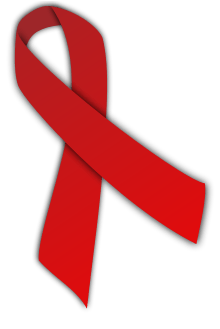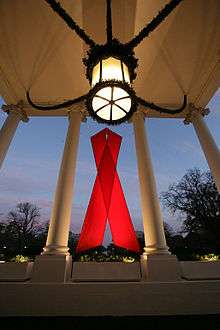Red ribbon

The red ribbon, as an awareness ribbon coloured red, is used as the symbol for the prevention of illegal drug, drunk driving, and to stop drugs. Also solidarity of people living with HIV/AIDS.[1]
Awareness symbol

The red ribbon is a symbol for drunk driving prevention, drug prevention, Blood disorders such as HELLP Syndrome and for the fight against AIDS. The Red Ribbon Foundation and Mothers Against Drunk Driving (MADD) are examples of organizations that utilize the red ribbon symbol. MADD is an organization founded in 1980 whose mission is to stop drunk driving, support the victims of this violent crime and prevent underage drinking. Red Ribbon International is an organization founded in 1993 whose main purpose is the education about prevention of the Human Immunodeficiency Virus or HIV, Acquired Immune Deficiency Syndrome Related Complex, ARC and AIDS.
Mothers Against Drunk Driving (MADD) Origins
In 1986, MADD started the "Tie One On For Safety"[2] campaign. It is MADD’s longest running and most visible public awareness project. During the holiday season, drivers are encouraged to tie MADD red ribbons to visible locations on their vehicles, or place window decals on their vehicles’ windows. The red ribbons represent the drivers’ commitment to drive safe, sober and buckled up. It also encourages others to designate a sober driver before drinking.
Alcohol, tobacco and other drug prevention awareness origin
The Red Ribbon was used as an awareness symbol made by after DEA Agent Enrique Camarena was kidnapped, tortured, and murdered while working undercover in Guadalajara, Mexico. Citizens in his home town of Calexico, California donned the ribbons to emphasize the need for increased prevention efforts. In 1988, Red Ribbon Week, sponsored by National Family Partnership, became a national campaign. It is celebrated from October 23 through October 31.
AIDS awareness origin
The Red Ribbon Project was created by the New York-based Visual AIDS Artists Caucus in 1991.[3]
- Remain anonymous as individuals and to credit the Visual AIDS Artists Caucus as a whole in the creation of the Red Ribbon Project, and not to list any individual as the creator of the Red Ribbon Project;
- Keep the image copyright free, so that no individual or organization would profit from the use of the red ribbon;
- The Red Ribbon should be used as a consciousness raising symbol, not as a commercial or trademark tool.
The artists who formed the Visual AIDS Artists Caucus wished to create a visual symbol to demonstrate compassion for people living with AIDS and their caregivers. Inspired by the yellow ribbons honoring American soldiers serving in the Gulf war, the color red was chosen for its, "connection to blood and the idea of passion—not only anger, but love, like a valentine." First worn publicly by Jeremy Irons at the 1991 Tony Awards,[4] the ribbon soon became renowned as an international symbol of AIDS awareness.
At the Freddie Mercury Tribute Concert held at Wembley Stadium, London on Easter Sunday 1992, more than 100,000 red ribbons were distributed among the audience by Red Ribbon International, with performers such as George Michael wearing one.[5][6] The Red Ribbon continues to be a powerful force in the fight to increase public awareness of HIV/AIDS and in the lobbying efforts to increase funding for AIDS services and research.
To symbolize the United States' commitment to combat the world AIDS epidemic, President George W. Bush's administration began displaying a 28-foot AIDS Ribbon on the White House's iconic North Portico on World AIDS Day 2007.[7][8] The display, now an annual tradition, quickly garnered attention, as it was the first banner, sign or symbol to prominently hang from the White House since Abraham Lincoln lived in the building.
Fair award
At fairs and competitions in Canada, a red ribbon is awarded to the winning competitor (first place). It is used for second place in the United States for horticultural fairs. In the U.S. in some judging competitions, particularly in 4-H and FFA livestock and horticultural competitions, red ribbons may be given to a project that meets some of the judging criteria but falls short in other areas, while superior projects and exhibits are awarded blue ribbons (which are second-place ribbons in Canada).
See also
- Paul Jabara - co-founder of the Red Ribbon Project
- Medals of Honor (Japan)
- Red Ribbon Agitation - a miners' rebellion in Australia
- Red tape
- World AIDS Day
References
- ↑ "World AIDS Day - 1 December". Retrieved 2009-02-13.
- ↑ "Tie One On For". Mothers Against Drunk Driving. Retrieved 2014-01-29.
- ↑ Familiar Studio, familiar-studio.com. "Visual AIDS". Visual AIDS. Retrieved 2014-01-29.
- ↑ Ribbon: The Art of Adornment p.22. Gibbs Smith, 2008
- ↑ Sander L. Gilman Diseases & diagnoses: the second age of biology p.50. Transaction Publishers, 2010
- ↑ Sarah E. H. Moore (2008) Ribbon culture: charity, compassion, and public awareness p.74. Palgrave Macmillan,
- ↑ "Two-Story AIDS Ribbon at White House". ABC News. November 30, 2007.
- ↑ "White House Marks World AIDS Day". The New York Times. November 30, 2009.
External links
| Wikimedia Commons has media related to Red ribbons. |
- Stars Wearing the AIDS Red Ribbon - slideshow by Life magazine
- Episode 173: Awareness, 99% Invisible, 21 July 2015 – an episode dedicated to the origin and takeoff of the red ribbon as a symbol of HIV/AIDS awareness